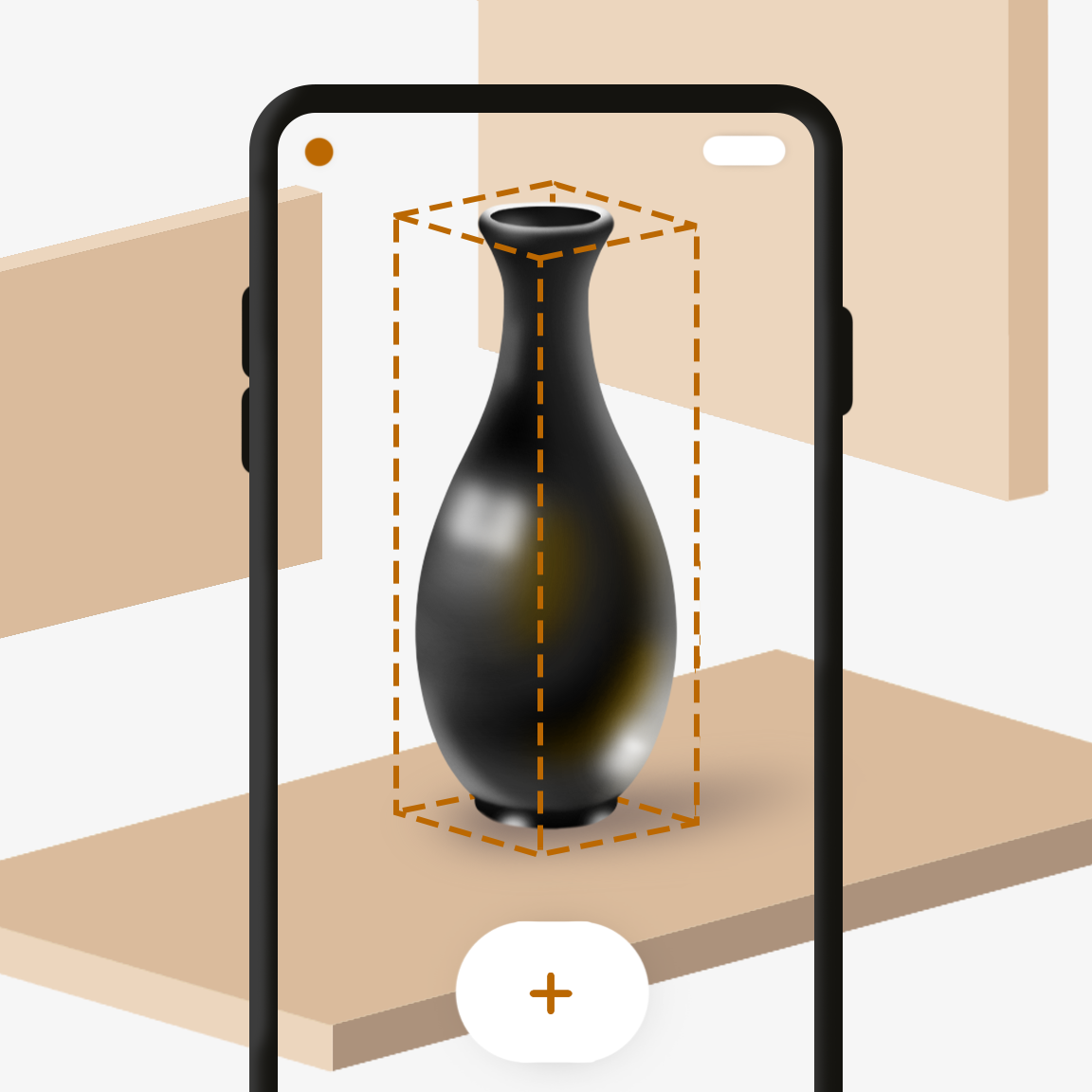Augmented reality, mixing virtual elements with the real world, is getting into ecommerce to bring new possibilities and change how customers interact with products and make purchase decisions.
By 2025, Statista predicts that approximately one-third of US shoppers will have embraced AR-powered technologies for their online purchases.
So, what exactly is augmented reality, and how can AR shopping benefit ecommerce businesses? Let’s find out in more detail.
What Is Augmented Reality?
Augmented reality (AR) has emerged as a groundbreaking tech that refers to the integration of computerized input, such as visuals, sounds, or haptic feedback, with the physical world in real-time.
AR creates immersive and interactive experiences by overlaying digital elements onto the user’s perception of reality, blurring the boundaries between the virtual and real realms.
Simulated reality relies on computer vision, tracking, and display technologies. Through advanced algorithms, computer vision can identify and monitor real-world objects and surfaces, facilitating precise placement of virtual elements in physical environments.
Tracking mechanisms can employ markers, sensors, or even AI to accurately line up virtual elements with the user’s point of view. From handheld gadgets to specialized headsets, display technologies smoothly project the simulated content into the user’s sight.
Different Types of AR
The AR tech encompasses various forms and uses. Here are some types of augmented reality types:
- Marker-based AR relies on the use of visual markers or patterns, typically printed images or symbols, to trigger and overlay virtual content on top of the real world. The markers act as reference points for the AR model to accurately position and overlay virtual elements or information within the real world.
- Markerless AR is also known as location-based or location-aware AR. It uses GPS, accelerometers, gyroscopes, and other sensors in mobile devices to determine the user’s location and orientation. Virtual materials are then overlaid onto the real world based on this data.
- Projection-based AR projects virtual content onto real-world surfaces to create an augmented environment. This can involve using projectors to display images, videos, or interactive elements onto walls, floors, or items.
- Superimposition-based AR involves overlaying computerized images or info onto real-world scenes in real-time. It uses computer vision to track the user’s movements and align the virtual content with the user’s perspective.
- Browser-based AR allows users to access virtual content directly through their browsers, making it more accessible and convenient. In the realm of digital marketing and advertising, the adoption of browser-based AR has proven to be a game-changer.
The field of computer modeling is changing fast, with new AR applications, practices, and variations always in the works.
Augmented Reality vs Virtual Reality: How They Stack Up
While both are transformative techs delivering immersive experiences, AR and VR are not as similar as one might think. They differ in their approach to altering our perception of reality.
Perception of Reality
AR enriches our perception of reality by blending digital content with the physical world. Users can see and interact with the real environment and virtual elements simultaneously.
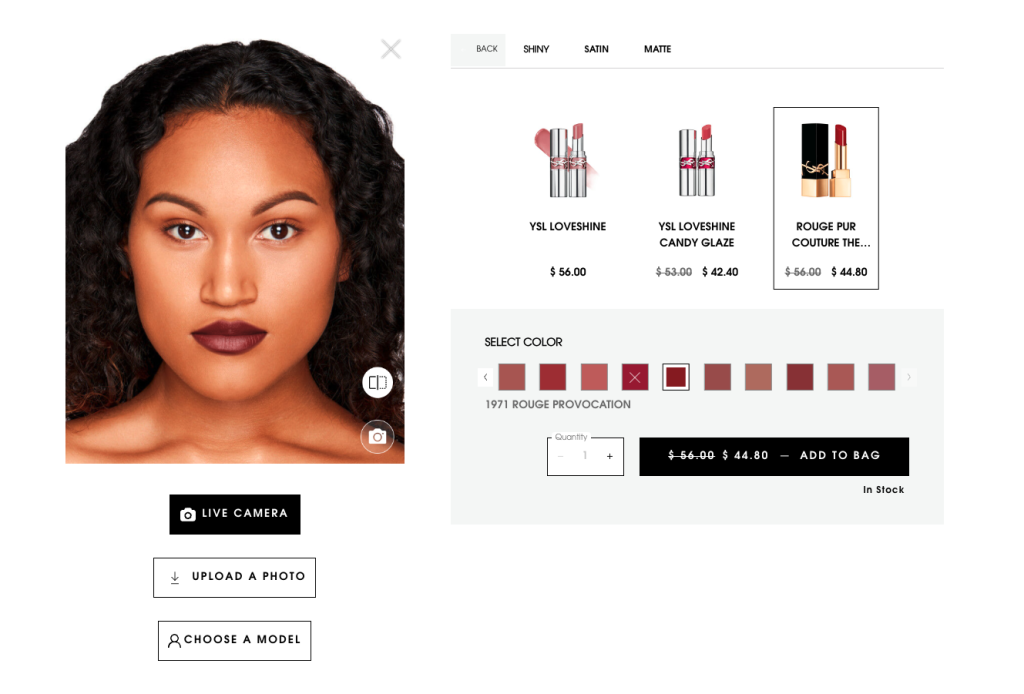
On the YSL website, shoppers can try on different products using their camera
In contrast, VR portrays a fully immersive digital atmosphere that replaces the real world. Viewers are completely isolated from their physical surroundings, and the virtual realm primarily stimulates their senses. This enables users to explore and interact with the virtual environment as if they were physically present.
Level of Immersion
AR provides a less immersive experience than VR since users remain aware of their physical surroundings while engaging with virtual content. This feature makes AR a great fit for situations where it’s crucial to stay aware of the real world, like helping with navigation, showing context at live events, or visualizing elements that aren’t present in the real world.
VR is an immersive experience that captivates viewers by engaging all their senses, transporting them to alternate realities. With the power to block out external distractions, VR is perfect for achieving total immersion and unwavering focus.
Devices Required
AR products can be experienced through various devices, from smartphones and tablets to dedicated smart glasses and headsets.
Well-known AR examples include mobile apps like Pokémon Go and Snapchat filters. These devices typically feature cameras, sensors, and display screens to overlay digital content in the real world.

Snapchat is well-known for its AR filters and masks
VR requires special headsets or goggles to fully immerse users in the virtual world. These head-mounted displays (HMDs) offer 3D visuals and usually come with built-in motion tracking and controllers to boost how users engage with the virtual environment.
High-end VR systems, such as the Oculus Rift and HTC Vive, require powerful computers for optimal performance.
How Online Retailers Use AR in Ecommerce
Augmented reality shopping is a powerful tool that creates a totally different consumer experience, ensuring new impressions and emotions for the customer. In the era of digitization and online business, retailers should leverage this tool to enhance, diversify, and improve their services.
Here is how web retail sellers use AR for shopping:
Virtual Product Try-ons
AR enables consumers to visualize how products look or fit in real-life settings before purchasing.
For example, in the fashion industry, customers can virtually try on clothes, shoes, or accessories using their smartphones or augmented reality devices.
This tech allows consumers to assess the product’s size, color, and style, enhancing their shopping experience with personalized product recommendations based on their preferences.
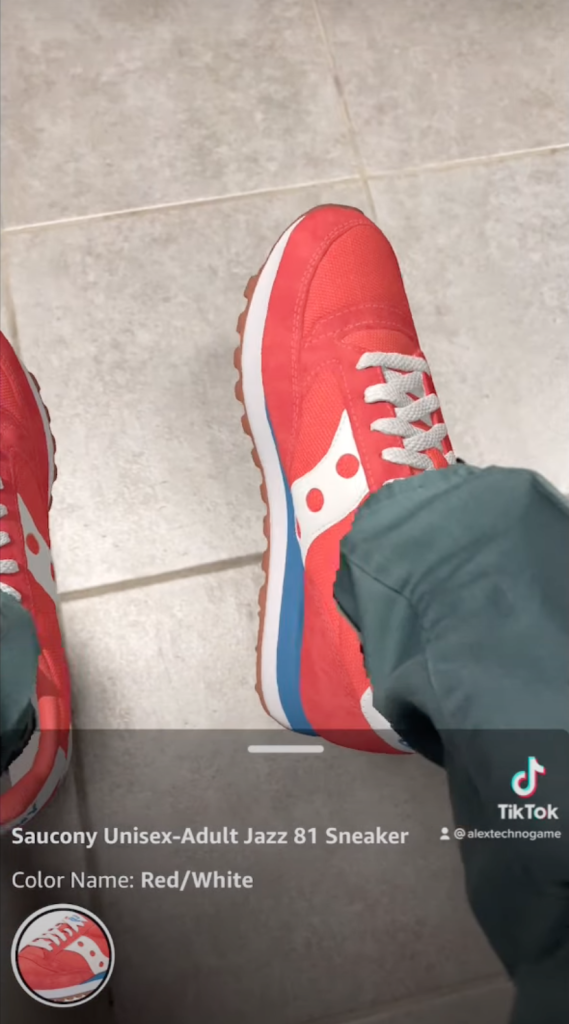
Amazon’s Virtual Try-On lets shoppers try on shoes using the Amazon app
Interactive Product Demonstrations
The tech enables ecommerce businesses to create interactive product demonstrations that go beyond traditional product images or videos. Users can better grasp the product’s features, functionality, and usage by overlaying digital data onto the real world.
For instance, furniture retailers can use AR to project virtual furniture into a buyer’s living space, allowing them to visualize how it would look and fit within their home environment.
Virtual Showrooms and Storefronts
AR for online shopping can provide customers with an authentic shopping experience from the comfort of their homes.
AR applications allow consumers to virtually explore a 3D representation of a physical store, browse products, and gain detailed info by interacting with virtual elements.
This not only enhances the convenience of online shopping but also helps businesses showcase their entire product catalog in a visually appealing manner.
Enhanced Product Details and Visualization
Customers can access additional details, such as specifications, user reviews, or tutorial videos, by scanning a product with their smartphones. This augmented data empowers customers to evaluate products thoroughly, increasing confidence in their purchase decisions.
Packaging and Unboxing AR Experiences
Customers can unlock hidden content by scanning the codes on packaging using AR-enabled devices, such as personalized messages, interactive games, or exclusive discounts. This not only adds an element of surprise and delight but also reinforces brand loyalty and encourages social sharing.
Companies That Have Already Embraced AR in Ecommerce
Many online retailers have integrated artificial reality tech into their platforms and created fully functional AR websites. These AR features enable their customers to enjoy advanced shopping experiences right from the comfort of their homes.
How IKEA Uses AR in Ecommerce
The furniture retailer IKEA launched an AR app called IKEA Place. With this app, users can virtually place furniture items in their homes using their smartphones or tablets.
Users can see how the furniture will look and fit in their space before purchasing. This immersive experience has helped clients visualize their purchases, see if they will be the right fit, and make more informed buying decisions.

Ikea is providing AR technology via their Ikea Place app, allowing customers to see what their furniture would look like in their home before ordering it
Augmented Reality Store by Sephora
A renowned cosmetics brand implemented AR technology in its Virtual Artist app. Users can try on various makeup products virtually using their smartphone’s camera. It uses facial recognition and mapping technology to accurately apply makeup to the human face, allowing users to experiment with different looks and shades.
An augmented reality store makes it easier for consumers to explore different products and find their perfect match without visiting physical stores.
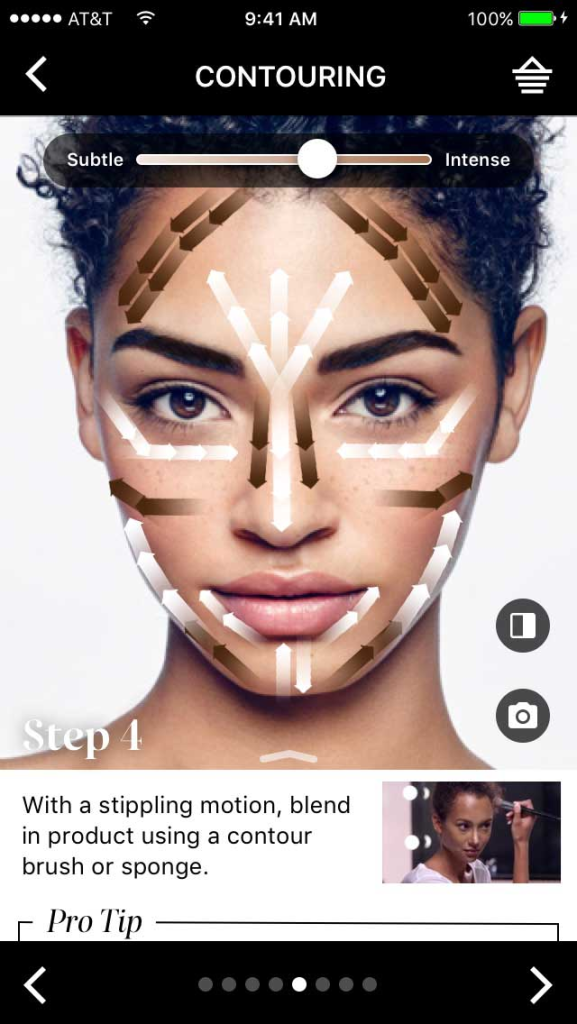
Sephora’s Virtual Artist app also offers make-up tutorials
Warby Parker’s Augmented Reality Shopping
An online eyewear retailer offers an AR reality feature within its app to help consumers try on glasses. Users can select frames they like and use their phone’s camera to see how the glasses look on their faces in a real-time format.
This experience has enabled consumers to accurately assess the fit and style of glasses, making the online shopping process more personalized, confident, and convenient.
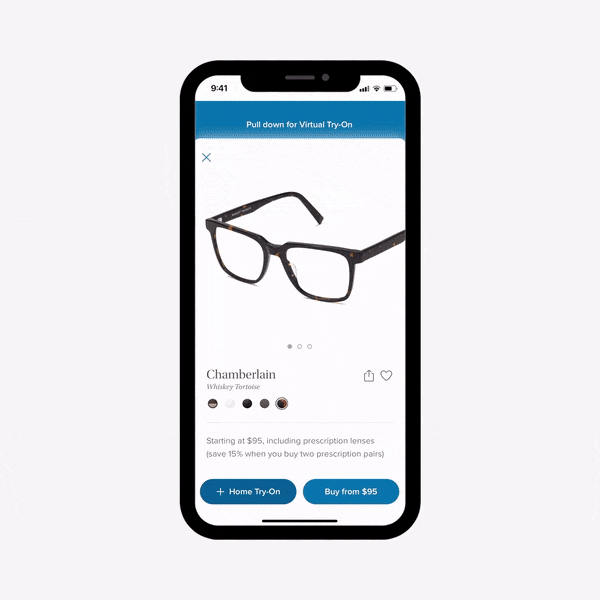
Warby Parker’s app shows shoppers how different frames will fit them
AR ecommerce by Wayfair
Specializing in home goods and furniture, the company has incorporated artificial reality into its mobile app. With Wayfair’s AR tool, users can visualize how furniture and decor items will look in their homes.
By placing virtual items in their space, buyers can assess size, color, and style options before making a purchase. It has proven to be an invaluable tool for consumers looking to furnish their homes and make confident buying decisions without visiting offline shops.

The Wayfair’s app allows users to position themselves in front of virtual products realistically
How Adidas Uses AR for Online Shopping
A global sports apparel and footwear brand has created a popular AR-driven app called Adidas Originals. It gives users an opportunity to access exclusive virtual experiences tied to specific products.
For example, they can try on sneakers, see product details in 3D, and even play interactive games. This integration has allowed Adidas to engage with its customers innovatively and win a strong competitive advantage.
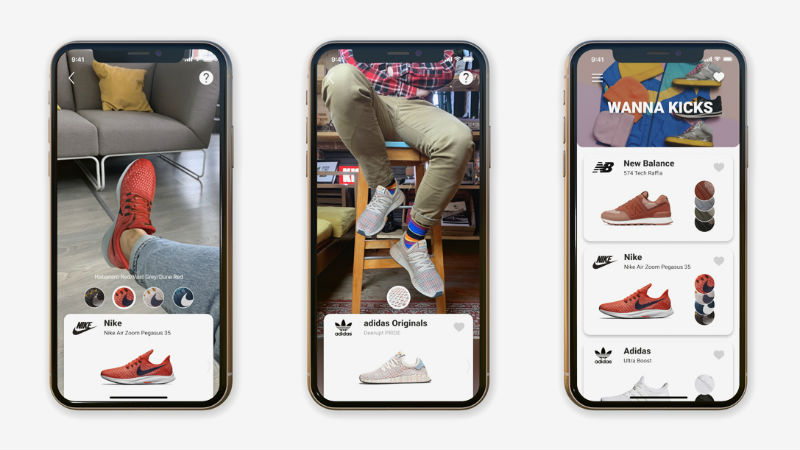
Trying on sneakers in the Adidas Originals app
AR shopping in James Allen
A well-known online retailer specializing in diamond engagement rings and fine jewelry has created an augmented reality platform for users to try on all their jewelry pieces.
The tech accurately renders the rings’ size, style, and design, giving purchasers a realistic representation of the jewelry. Users can rotate and zoom in on the virtual ring, allowing them to examine intricate details such as the diamond’s cut, clarity, and color and find their perfect ring.

The James Allen app lets users try on engagement rings in three steps
Implementing AR in Ecommerce Store: Steps to Take
At this point, it’s clear that augmented technology is a beneficial feature for online retailers to embrace. So, if you are about to implement it in your online store, follow these steps to ensure a successful and efficient AR integration.
Determine Your Objectives
First and foremost, identify the specific goals you want to achieve with the tech, such as enhancing product visualization, reducing returns, boosting conversions, or improving client engagement. Having a clear vision will guide you through the process.
Choose an Appropriate AR Solution
Several options are available, ranging from third-party AR platforms to customized solutions. Consider factors such as ease of integration, compatibility with your existing platform, pricing, and customer support. Look for solutions that offer features like 3D models for ecommerce, real-time rendering, and seamless integration with your product catalog.
Although certain AR solutions for ecommerce may come with a high price tag and demand technical knowledge—budget- and user-friendly alternatives are also available.
Take Ecwid by Lightspeed, for example. Apart from being a robust ecommerce platform, it also offers a mobile app for iOS that has a 3D modeling feature. It works with Apple Pro devices with a LiDAR scanner, which means you can use just your phone to create a 3D model of your product.
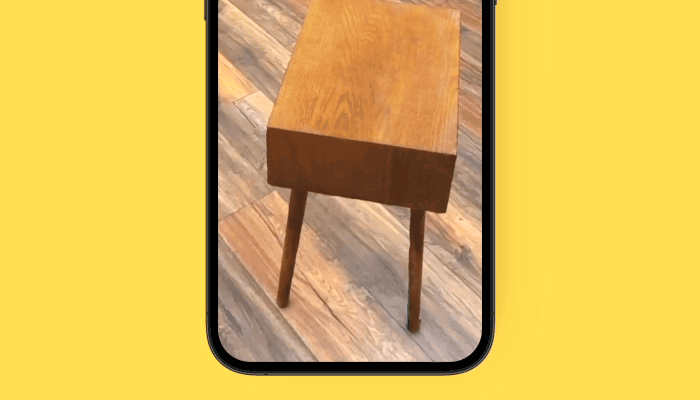
A 3D model of a product made with the Ecwid Mobile App
All you have to do is use your phone to scan a product, and the app will do the rest. You’ll then get a 3D product model that will be available on the product page.
Imagine this: a customer opens your app or website, picks a product (a coffee table, for example), and, with a click, their phone or tablet screen becomes a stage for their new purchase. They can rotate, zoom, and place the 3D model in their living room to see how it fits their decor.
Learn more about easily creating 3D models of products for your ecommerce store:
Prepare Your Product Catalog
To enable AR functionality, you need to create 3D models or obtain them from your suppliers. Start by selecting the products you want to offer in AR and ensure they have accurate and detailed specifications.
Hire 3D modeling professionals or outsource this task to specialized agencies if necessary. Alternatively, explore 3D modeling software that allows you to create basic models in-house.
As mentioned above, if you use the Ecwid Mobile App for iOS, you can make 3D models of products yourself using just your phone.
Integrate AR into Your Online Store
Connect the chosen solution with your existing shopping platform to integrate AR into your online store. When using a third-party platform, follow their integration guidelines, which often include installing an AR plugin or embedding code snippets into your website. Work closely with your web development team to ensure a smooth integration process and minimal disruptions to your store’s functionality.
For Ecwid users, this step is not necessary. The Ecwid 3D modeling feature seamlessly integrates with your store, making it easy to add AR functionality without any additional coding or integrations.
Optimize AR Performance
For a top-notch virtual experience, prioritize optimal performance. Boost your website’s loading speed, especially as AR demands extra resources. Condense your 3D models and textures without sacrificing quality, and implement effective caching methods.
Regularly test your AR features on different devices and browsers to ensure compatibility and smooth operation.
Promote Your AR and Educate Your Customers
Update your product pages to highlight the availability of AR, providing clear instructions on how to access and use it. Juggle with various marketing channels, including social media, email campaigns, and blog posts, to inform your audience about the benefits of AR in your ecommerce store.
If you create your 3D product models with Ecwid, your customers can conveniently view the model directly on the product page.
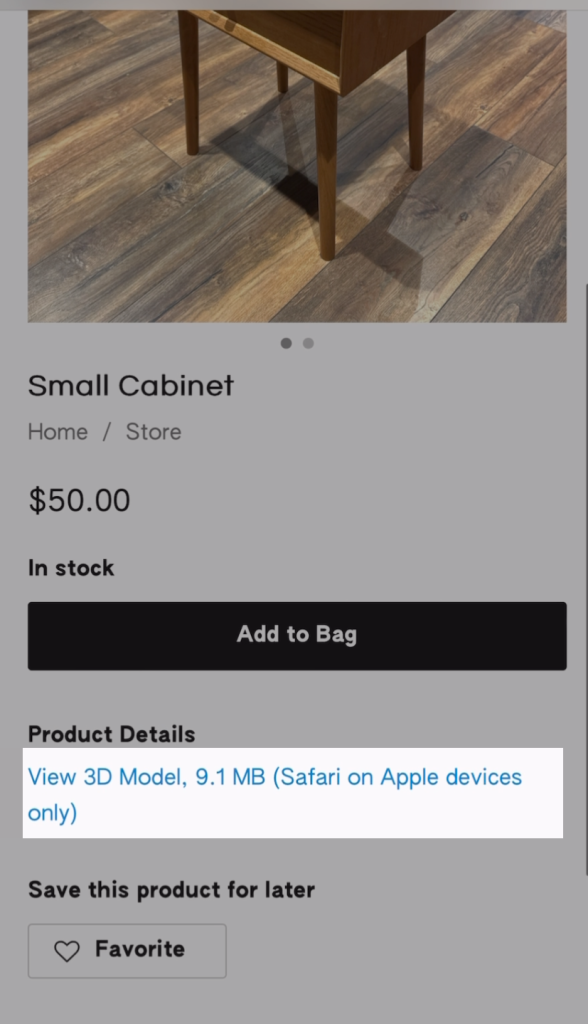
Customers can view a 3D model on a product details page
Collect and Analyze Data
Implement analytics tools to gather data on AR usage and consumer behavior. Monitor metrics such as engagement scores, conversion rates, and customer feedback.
Analyze this data to gain insights into your virtual functionality’s effectiveness, identify improvement areas, and make data-driven decisions to optimize your AR tools further.
To Sum Up: AR Benefits for Eсommerce
In the world of online shopping, where everything happens virtually, using AR brings benefits that don’t just catch shoppers’ eyes but also totally change how they shop. This tech lets you explore and engage in new ways, giving you a super immersive and fun shopping experience.
Visualizing Products in Real-Life Scenarios
Introducing AR ecommerce elevates the shopping experience. Customers use smartphones or wearables to overlay virtual products on their surroundings, visualizing furniture, decor, clothing, and beauty items in real life.
This interactive experience eliminates guesswork and induces shoppers to make more informed purchasing decisions.
Eliminating Size and Fit Worries
AR technology solves a long-standing challenge in online shopping — the uncertainty of size and fit.
With AR, consumers can virtually try on clothing, accessories, or glasses, accurately assessing how they would look on themselves. This feature not only enhances convenience but also reduces the likelihood of returns, resulting in increased customer satisfaction and cost savings for online retailers.
Minimizing Returns and Enhancing Customer Satisfaction
Returns are a common issue in online retail, as consumer expectations may not match the products received. AR helps by showing accurate product representations before purchase.
Incorporating AR can help minimize unexpected surprises and reduce return rates, raise consumer satisfaction, and build trust between customers and retailers.
Creating Personalized Shopping Experiences
Using AR, retailers analyze buyer preferences, purchase history, and contextual data to provide personalized product recommendations and promotions. Customizable AR virtual showrooms cater to individual interests, creating an engaging, personalized client environment.
Furthermore, combining the power of augmented reality with digital marketing and advertising strategies can amplify the impact of personalized product recommendations and promotions.
Increasing Customer Engagement and Interactivity
Augmented reality in ecommerce adds fun and interactivity to online shopping, enhancing client engagement. AR transforms shopping into an immersive experience, allowing users to interact with virtual products via gestures, voice, or touch.
This heightened engagement leads to increased time spent on ecommerce platforms, improved brand loyalty, and higher conversion rates.
Bridging the Online-Offline Gap
AR in ecommerce can bridge the gap between online and offline shopping. By allowing consumers to experience products virtually, AR can entice them to visit physical stores or showrooms to make final purchases.
Additionally, AR-enabled QR codes or markers can be used in-store to provide customers with supplementary information, promotions, or exclusive deals, further enhancing their shopping journey.
Boosting Brand Awareness
AR technology takes digital marketing and advertising to a whole new level. Marketers use computerized product demos and ads to present their offerings in a captivating, interactive way.
Moreover, teaming up with influencers and offering cool AR experiences like filters and masks lets businesses connect with their audience on social media. It creates shareable moments that boost brand awareness and get customers involved.
So, augmented reality app development lets businesses discover new ways to make immersive branded experiences. It helps them step up their game in boosting brand awareness by creating engaging and interactive campaigns that really connect with their audience.
Augmented reality has certainly become a game-changer in ecommerce, providing immersive experiences, enhancing client engagement, reducing uncertainty, and boosting sales. Its impact is undeniable. As the AR industry evolves, it will keep transforming and enhancing online retail.
Businesses that embrace technology today can mold the future of ecommerce, offering outstanding customer experiences and gaining the benefits of a competitive advantage.
- SEO Powered Content & PR Distribution. Get Amplified Today.
- PlatoData.Network Vertical Generative Ai. Empower Yourself. Access Here.
- PlatoAiStream. Web3 Intelligence. Knowledge Amplified. Access Here.
- PlatoESG. Carbon, CleanTech, Energy, Environment, Solar, Waste Management. Access Here.
- PlatoHealth. Biotech and Clinical Trials Intelligence. Access Here.
- Source: https://www.ecwid.com/blog/augmented-reality-in-ecommerce.html


